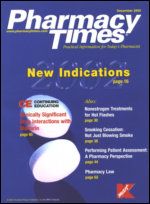Publication
Article
Pharmacy Times
Nurse Diversion in Health Facilities?Part I
Author(s):
The diversion of controlled substances by nurses in health facilities is a significant problem in the United States. Because nurses are the largest number of health professionals in any given state, and because they have excellent access to controlled pharmaceuticals, it is understandable that nurses are the largest number of diverters.
Although meperidine seems to be finding less and less favor with physicians as a preferred pain reliever, this drug is usually the most commonly abused controlled substance at the nurse?s disposal. If meperidine is not available in the health facility, other narcotic pain relievers or benzodiaze-pines may be abused.
Meperidine addictions have involved as much as 3000 mg a day in some of the most egregious cases. The nurses in these cases experienced blackouts and seizures, oftentimes not remembering activities they performed on their shift. Many of those at the highest levels had been caught diverting prescription drugs in previous facilities at which they had been employed. These health facilities had merely fired them and allowed them to continue their illegal behavior and unchecked addiction. As mentioned in last month?s article, this is a disservice to a health professional, whose addiction only becomes worse at the next facility, while the individual continues to cause discomfort to patients.
One of the most common methods of nurse diversion is to prey on the patient receiving a drug on an as-needed basis. The common scenario is to give part or none of the medication to the patient exactly on schedule during the shift. The nurse documents, however, that the maximum amount of pain reliever was administered to the patient. This type of diversion guarantees that the drug count at the end of the shift will be correct?for a while. Eventually the addiction rises and the diverting nurse becomes sloppy in attempting to document medication administrations that never took place.
Excessive wastage is another popular form of drug diversion in the health facility. Although a witness is required for the wastage of controlled substances, many times the diverting nurse does not get a witness. The nurse will later request a verifying signature from other nurses on the shift, with the excuse of having been too busy to get the documentation at the time the drug was administered. In many states, nurses who sign these documents without witnessing the wastage can be guilty of felony criminal drug violations.
Usually the best detector of diversion in the health care facility is the hospital pharmacist or the pharmacist supplying drugs to the nursing home. Pharmacists who are diligent, do spot checks, and work well with nurse managers will be the most successful in keeping this problem under control.
If the pharmacy has a computer-generated dispensing system, it can likely be used to conduct covert audits of the administration of narcotics. Virtually any information that is put into the system can be retrieved. This would include comparing a specific nurse?s administration of meperidine or other highly diverted narcotics with that of other nurses dealing with similar patients in like areas of the health facility. Unusually high incidence of drug administration does not mean that diversion is taking place but may warrant further investigation.
In 1 of our hospital investigations, 5 nurses in the same unit were checked for their injectable administration of class 2 drugs over a 30-day period. The computer data indicated that 4 of the nurses had very similar amounts of class 2 administration over this time period. All 4 of those nurses worked full-time at the hospital.
The fifth nurse, however, who worked only part-time every other day at the facility, showed almost 5 times as much narcotic administration during this 30-day period. A more detailed check of her administration records indicated that she had documented giving class 2 drugs to patients who had already been discharged from the hospital. She had reached the level of 2500 to 3000 mg of meperidine a day, and she was still functioning somewhat as a nurse!
John Burke, director of the Warren County, Ohio, drug task force and retired commander of the Cincinnati Police Pharmaceutical Diversion Squad, is a 32-year veteran of law enforcement.For information, he can be reached by e-mail at [email protected], by phone at 513-336-0070, or via the Web site www. rxdiversion.com.

Newsletter
Stay informed on drug updates, treatment guidelines, and pharmacy practice trends—subscribe to Pharmacy Times for weekly clinical insights.






